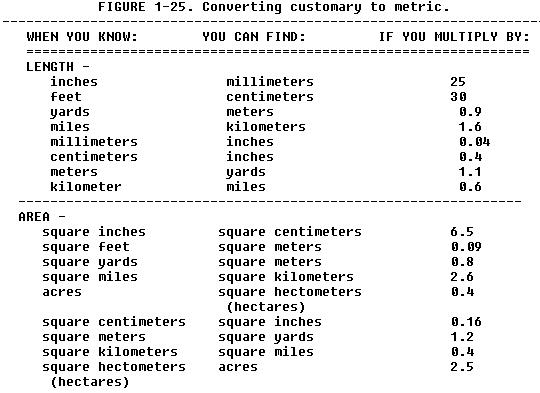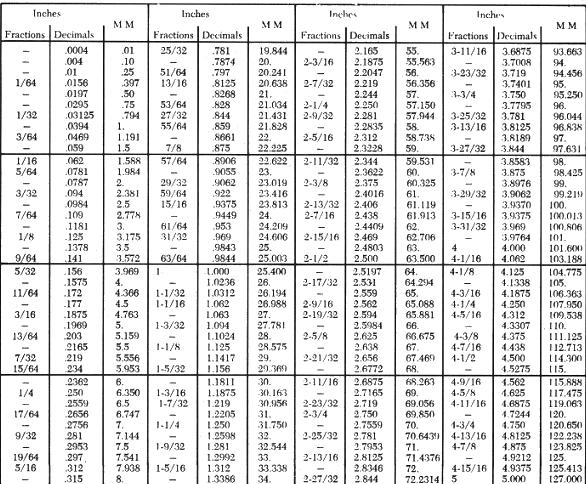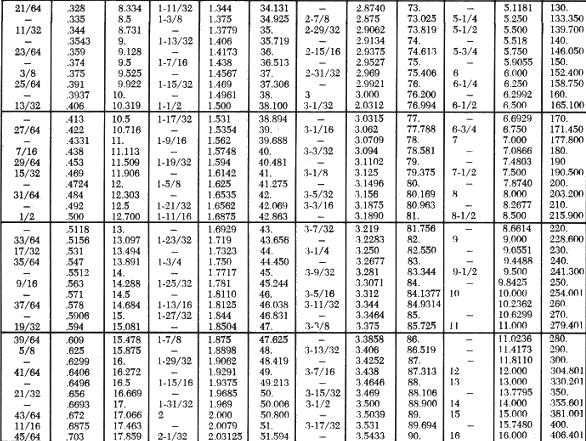MEASUREMENTSYSTEMS
MEASUREMENT SYSTEMS
| Our customary system of measurement (figure 1-23) is part
of our cultural heritage from the days when the thirteen colonies were
under British rule. It started as a hodge-podge of Anglo-Saxon, Roman,
and Norman-French weights and measures. Since medieval times, commissions
appointed by various English monarchs had reduced the chaos of measurement
by setting specific standards for some of the most important units. Early
records, for instance, indicate that an inch was defined as the length
of "three barleycorns, round and dry" when laid together; a pennyweight,
or one-twentieth of a Tower ounce, was equal to 32 wheatcorns from the
"midst of the ear."
The U.S. gallon is the British wine gallon, standardized at the beginning
of the 18th century (and about 20 percent smaller than the Imperial gallon
that the British adopted in 1824 and have since used to measure most liquids).
In short, as some of the founders of this country realized, the customary
system was a makeshift based largely on folkways.
Metric System
|
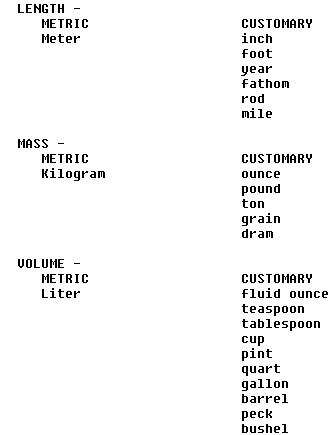
|
| The metric system is the dominant language of measurement in use today.
Most of the world countries used the metric system prior to World War II.
Since the war, more countries have converted or are in the process of converting
to the metric system. Only the United States and 13 smaller countries have
not made the conversion.
Congress has the power to define the standard of weights and measures.
Repeatedly the metric system has been proposed and each time the question
has been voted down. |
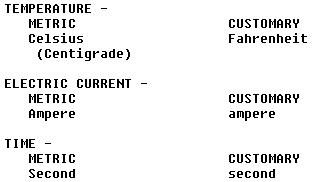
|
|
Figure 1-23 Some common units
|
The metric system was developed by a French statesman, Talleyrand, Bishop
of Autum, using a "meter" as a standard; the meter being a specific portion
of the circumference of the earth at the equator. From this base measurement
the meter was developed and accepted as the standard. Divisions and multiples
of the meter are based on the decimal system.
The Logic of Metric
No other system of measurement that has been actually used can match
the inherent simplicity of International Metric. It was designed deliberately
to fill all the needs of scientists and engineers. Laymen need only know
and use a few simple parts of it. It is logically streamlined, whereas
other systems developed more or less haphazardly. At this time there are
only six base units in the International Metric System. The unit of length
is the meter. The unit of mass is the kilogram. The unit of time is the
second. The unit of electric current is the ampere. The unit of temperature
is the kelvin (which in common use is translated into the degree Celsius,
formerly called degree centigrade). The unit of luminous intensity is the
candela.
All the other units of measurement in the International Metric System
are derived from these six base units. Area is measured in square meters;
speed in meters per second; density in kilograms per cubic meter. The newton,
the unit of force, is a simple relationship involving meters, kilograms,
and seconds; and the pascal, unit of pressure, is defined as one newton
per square meter. In some other cases, the relationship between the derived
and base units must be expressed by rather more complicated formulas -
which is inevitable in any measurement system, owing to the innate complexity
of some of the things we measure. Similar relationships among mass, area,
time and other quantities in the customary system usually require similar
formulas, made all the more complicated because they can contain arbitrary
constants. For example, one horsepower is defined as 550 foot-pounds per
second.
The third intrinsic advantage is that metric is based on the decimal
system. Multiples and submultiples of any given unit are always related
by powers of 10. For instance, there are 10 millimeters in one centimeter;
100 centimeters in one meter; and 1,000 meters in one kilometer. This greatly
simplifies converting larger to smaller measurements. For example, in order
to calculate the number of meters in 3.794 kilometers, multiply by 1,000
(move the decimal point three places to the right) and the answer is 3,794.
For comparison, in order to find the number of inches in 3.794 miles, it
is necessary to multiply first by 5,280 and then by 12.
| Moreover, multiples and submultiples of all the International
Metric units follow a consistent naming scheme, which consists of attaching
a prefix to the unit, whatever it may be. For example, kilo stands for
1,000: one kilometer equals 1,000 meters, and one kilogram equals 1,000
grams. Micro is the prefix for one millionth: one meter equals one million
micrometers, and one gram equals one million micrograms (figure 1-24).
Conversion: Metric To Conventional |

|
People tend to resist changes, usually because they do not understand
either the purpose of the change or the new order. Terminology for customary
units and metric units have been discussed. A conversion table also has
been included. Examples of its use follow:
To convert inches to millimeters, multiply the number of inches by 25.
(Ex. 25 into mm = 25 x 25 = 625 mm)
To convert millimeters to inches multiply millimeters by 0.04. (Ex.
625 mm x 0.04 = 25 inches.)
To convert square inches to square centimeters multiply by 6.5. (Ex.
100 sq in x 6.5 = 650 sq cm)
To convert square centimeters to square inches multiply by 0.16. (Ex.
100 x 0.16 = 16 sq in)
Figure 1-26 is practically self explanatory. Measurements starting at
1/64 inch up to 20 inches have been converted to decimal divisions of inches
and to millimeters.



